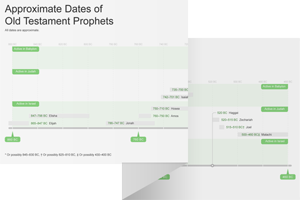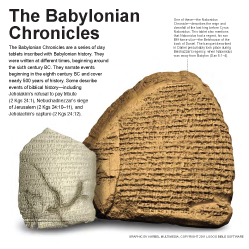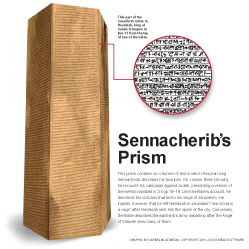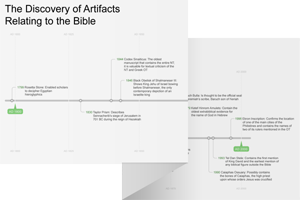1:1–3:19 The book of Nahum, |
1:1 The oracle concerning The Hebrew term here refers to a form of speech and also means “burden” (e.g., Jer 23:33). The term is common in identifying a prophet’s oracle (e.g., Isa 13:1; 15:1; 17:1; 19:1; Ezek 12:10; Hab 1:1; Zech 9:1; 12:1; Mal 1:1).
 Oracles against the Nations Table
Oracles against the Nations Table
Nineveh A city located on the east bank of the Tigris River in northeastern Mesopotamia (in modern Iraq). At the time of Nahum, Nineveh was the capital of the Assyrian Empire, which dominated the ancient Near East. See note on Jonah 1:2.
the scroll of This is the only occurrence where the heading of a prophetic book explicitly identifies the work as a written document using this Hebrew word, sepher. This may indicate the book of Nahum was intentionally crafted as literature.
the vision of The Hebrew word used here appears in the opening of the books of Obadiah (Obad 1:1) and Isaiah (Isa 1:1). It is commonly used for prophetic messages (Hab 2:2; Mic 3:6; Ezek 12:22).
 Prophetic Commissioning and the Divine Presence
Prophetic Commissioning and the Divine Presence
Nahum A prophet of God who announced the forthcoming destruction of Nineveh.
Nahum |
Elkoshite Nahum is the only ot text to mention Elkosh. The location may be the same as Capernaum, meaning “city of nahum (comfort).”
1:2–15 This section (vv. 2–15) is a poetic hymn centered on God’s sovereignty. The first part (vv. 2–8) is similar to a praise psalm like Psa 145. Nahum describes Yahweh’s power and character, emphasizing His ability to bring His enemies to a complete end (Nah 1:9–11). The conclusion of the oracle reassures the people of Judah that their oppression by Assyria is coming to an end (vv. 12–15). There is some ambiguity over whether v. 15 should be read as the end of the first oracle or as the opening of the second oracle in ch. 2. In Hebrew, v. 15 is numbered 2:1 and taken as the beginning of the next section. However, v. 15 makes sense as the conclusion to the announcement of Assyria’s downfall in v. 14. |
1:2 full of wrath The Hebrew phrase used here, ba'al chemah, literally means “lord of anger.” The first of these Hebrew words, ba’al, is also the name of the Canaanite god of storm and fertility.
Yahweh takes vengeance against his enemies Vengeance belongs to Yahweh (Deut 32:35–43). The name “Yahweh” occurs three times in this verse.
1:3 slow to anger The wording echoes the common formulaic expression of Yahweh’s attributes—balancing mercy and compassion with holiness and justice (compare Exod 34:6–7; Num 14:18; Joel 2:13; Jonah 4:2; Neh 9:17; Pss 86:15; 103:8; 145:8).
in storm wind and in gale A hendiadys (i.e., “violent windstorm”). As opposed to the impotent storm gods of the pagan fertility cults (e.g., Baal-Hadad), Yahweh is the omnipotent storm God.
storm clouds are the dust of his feet A popular motif throughout the Bible (e.g., 2 Sam 22:10; Pss 97:2; 104:3; Isa 19:1; Matt 24:30; Rev 1:7).
1:4 Bashan A region in northeastern Israel noted for its lush vegetation (see Amos 4:1 and note). Isaiah 33:9 also mentions these three locations (Bashan, Carmel, Lebanon) together.
Carmel A ridgeline in northwestern Israel noted for its lush vegetation (Jer 46:18).
Lebanon An extended coastal mountain range located northwest of Israel. Lebanon (or Phoenicia) is famous for its cedar trees, which were prized throughout the ancient Near East.
1:5 Mountains quake before him A common poetic motif in the ot (compare Judg 5:4–5; Psa 114:4–7; Jer 4:24; Hab 3:10). The language of the mountains quaking is often associated with theophany. Yahweh’s arrival on earth is characterized by storm, fire, and earthquakes.
Yahweh’s arrival on earth is characterized by storm, fire, and earthquakes.
1:7 he knows those who take refuge in him The Hebrew term here denotes the sense of protection or providence.
1:8 a rushing torrent Archaeological excavations have shown that Nineveh was partially destroyed by floodwaters from the Tigris River (compare the Babylonian Chronicles).
into darkness May be a reference to Sheol, the underworld and the land of darkness (see Job 14:13).
1:9 What do you plot against Yahweh The Hebrew expression here could be a rhetorical question about Nineveh’s schemes against Yahweh. It also could be a direct statement: “Whatever you plot against Yahweh.”
a second time The Assyrians rose up for the first time when they invaded the southern kingdom of Judah in 701 bc (see note on Nah 1:11).
1:10 thorns The imagery here illustrates the complete destruction that will come upon Assyria.
1:11 one who plots evil against Yahweh Likely refers to Sennacherib, the Assyrian king who reigned from 705–681 bc. In 701 bc, Sennacherib invaded Judah, destroying 46 cities before preparing a siege of Jerusalem. In response to King Hezekiah’s prayer for deliverance (2 Kgs 19:19), the Angel of Yahweh struck down 185,000 Assyrians in a single night (2 Kgs 19:35).
the Assyrian king who reigned from 705–681 bc. In 701 bc, Sennacherib invaded Judah, destroying 46 cities before preparing a siege of Jerusalem. In response to King Hezekiah’s prayer for deliverance (2 Kgs 19:19), the Angel of Yahweh struck down 185,000 Assyrians in a single night (2 Kgs 19:35).
wickedness The Hebrew term used here, beliyya'al, occurs throughout the Old Testament to identify the most reprehensible characters (e.g., Judg 19:22; 1 Sam 10:27; 1 Kgs 21:10).
1:13 yoke A wooden or iron frame placed on the backs of draft animals (such as oxen, horses, or donkeys) so they could pull a cart or plow. A yoke usually consisted of a single crossbar with leather or rope nooses placed around the animals’ necks. The yoke symbolizes submission to foreign oppression. Yahweh will break Assyria’s power and end its dominance of Judah (compare Isa 10:27; Jer 28:2, 10).
1:14 Your name will no longer be sown Nahum declares that the Assyrian race will be cut off.
the temple of your gods Refers to the temple of Ishtar in Nineveh.
your gods The gods of the Assyrians would not be able to save the nation from the wrath of Yahweh.
the idols and images Describes idols, images, or statues of a deity. Ancients most often carved idols out of wood or stone, but they also could fashion them from metal. They worshiped idols as the visible manifestation of the deity—a practice Yahweh condemns in the Ten Commandments (Exod 20:4).
images, or statues of a deity. Ancients most often carved idols out of wood or stone, but they also could fashion them from metal. They worshiped idols as the visible manifestation of the deity—a practice Yahweh condemns in the Ten Commandments (Exod 20:4).
1:15 the one who brings good tidings Refers to a herald who brings news of victory and announces the coming of Yahweh’s deliverance for His people (compare Isa 40:9 and note).
your festivals Refers to the yearly feasts of the Jewish calendar: the Feast of Unleavened Bread, the Feast of Weeks, and the Feast of Tabernacles (Lev 23).
 Israelite Festivals Table
Israelite Festivals Table
your vows An offering promised to Yahweh (Lev 7:16; 22:18; 23:38).

|
About Faithlife Study BibleFaithlife Study Bible (FSB) is your guide to the ancient world of the Old and New Testaments, with study notes and articles that draw from a wide range of academic research. FSB helps you learn how to think about interpretation methods and issues so that you can gain a deeper understanding of the text. |
| Copyright |
Copyright 2012 Logos Bible Software. |
| Support Info | fsb |
 Loading…
Loading…


 Nahum
Nahum 



